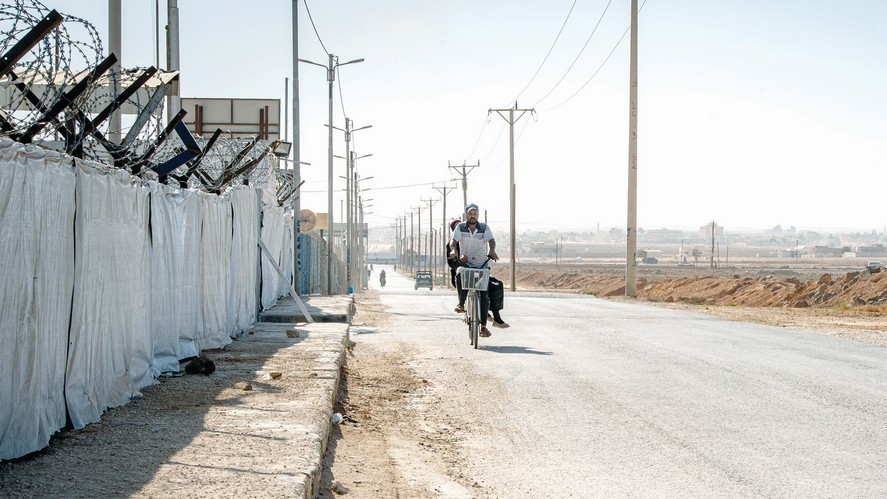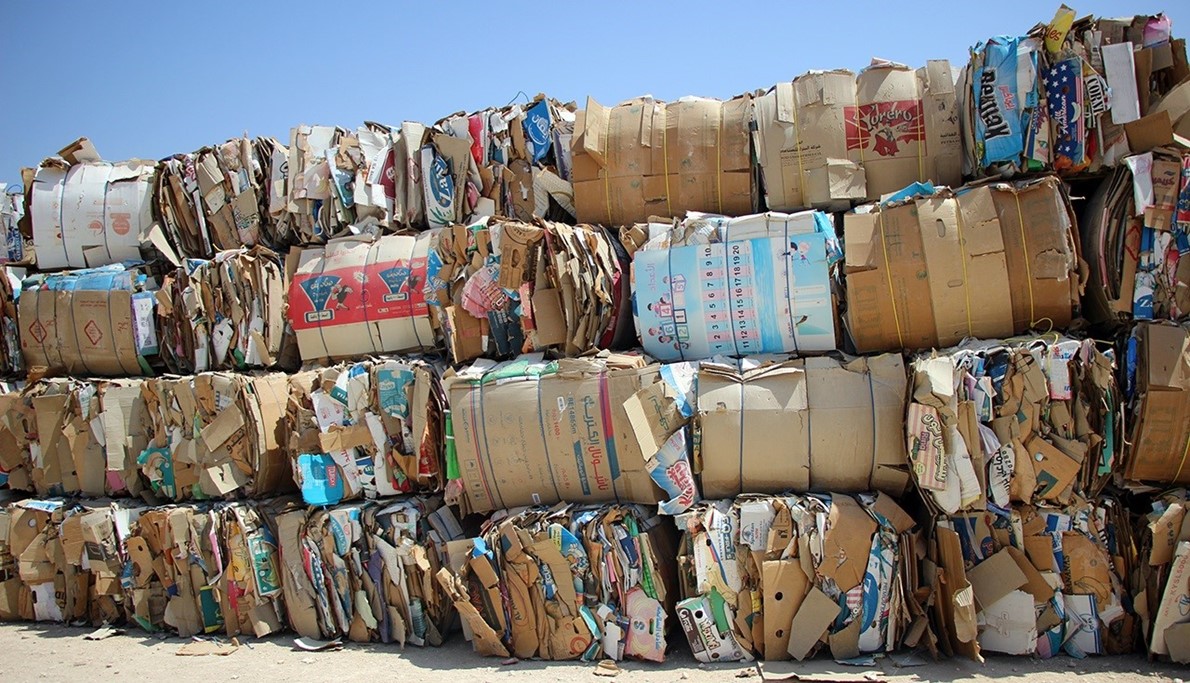Inside the metal walls of a caravan, Abu Malek, his wife, and two of their
kids sit on three mattresses laid on the ground. A flickering light — powered
by an external battery bought from a mechanic in the camp a day prior for JD5 —
hangs overhead and a TV and metal fan sit idly in the corner, off due to a power
outage.
اضافة اعلان
Abu Malek and his five kids — who became six in the
camp, three boys and three girls — made their way from Inkhil Daraa to Jordan
on January 27, 2013. Abu Malek’s end goal, ever since he started town hopping
searching for refuge in Syria, is to educate his children and find safety and
quiet.
“I chose this location in the camp when we first
came because it was far and quiet,” he said.
“It (the area) still did not have services, so no
one was there. I wanted to be alone.”
 A refugee rides a bike inside Zaatari refugee camp. Bikes alongside trolleys are used as the main transportation mode for refugees. (Photo: Ofxam)
A refugee rides a bike inside Zaatari refugee camp. Bikes alongside trolleys are used as the main transportation mode for refugees. (Photo: Ofxam)
Zaatari Refugee Camp in
Mafraq Governorate saw its
first tents pitched a decade ago. Now, 12km from the Syrian border, the camp is
home to 82,000 Syrian refugees, 40 percent of who are under 11 years old. Some
of the younger camp residents know nothing but the borders of the camp.
Abu Malek’s youngest daughter Dmou’, meaning tears
in Arabic, is eight. Born and raised in the camp, she is the only sibling still
in school.
At the beginning, Abu Malek was hesitant to send his
daughters to schools, much like he was worried about leaving his tent due to
harassment and security concerns. But the situation flipped “100 degrees” since
then, he said.
“No security cars were allowed among the tents back
then. Even to get our groceries, I would get them and go straight back. ...
With (the) amounts of tents, you could easily get lost.”
Zaatari has 32 schools; all are in recess for the
summer. Dmou’s brothers, 17 and 15, left school due to lack of income and
health issues.
The 15-year-old has a serious speech impairment and
suffers from a disability that impacts his capability to learn. He takes weekly
speech therapy classes alongside writing classes, but Um Malek says there is
little improvement. He spends his day with his younger sister Dmou’, watching
videos on the phone. Their mother said he does not leave the caravan due to
bullying, but will sometimes sit outside with the family.
His medicine, which costs JD50 a month, worsened the
financial situation of the already destitute family who had to stop buying it
for two months now.
At 16, Abu Malek’s other son, now 17, “was top of
his class”, his mother said. He left school as he reached 10th grade because
his father fell ill and was not able to work. He currently works in the city of
Salt at a water station.
 The “Sham Elysee”, a 3km-long thoroughfare that is home to a bustling market, including barbershops, bridal stores, grocery shops, restaurants, and more. (Photo: Jude Taha/Jordan News)
The “Sham Elysee”, a 3km-long thoroughfare that is home to a bustling market, including barbershops, bridal stores, grocery shops, restaurants, and more. (Photo: Jude Taha/Jordan News)
“I regret it, we all worry for him. We told him he
should go back, but he keeps saying ‘I need something I can help you with, not
school’,” his mom said.
Abu Malek, sporting a green Oxfam vest, said he
currently works in recycling.
“It is going well, allhamdulillah (thanks to God),”
he said. Zaatari’s waste separation at household level stands at an impressive
80 percent.
Abu Malek used to work on a farm in Syria; while in
Zaatari, he worked on some farms outside the camp, but the pay “could not
guarantee the rent”, he said.
“The effort to leave the camp and get a permit is
not worth it. The reward is not enough.”
“I used to cry for him. He would leave the camp at
three or four in the morning and come back utterly exhausted, and for what? A
barely livable wage,” said Um Malek.
Currently, their caravan gets electricity 10 hours a
day at most, much like the rest of the camp. Their water has been cut for three
days.
“We used to get water every eight days, now we have
to wait for 12 days,” said Um Marwan.
 Compacted boxes of cardboard at Oxfam’s Zaatari facility. A box weighs near 200kg. (Photo: Jude Taha/Jordan News)
Compacted boxes of cardboard at Oxfam’s Zaatari facility. A box weighs near 200kg. (Photo: Jude Taha/Jordan News)
By the first quarter of 2022, only 27 percent of
working-age Syrian refugees in Jordan had work, the
UNHCR’s 2022 Q1 refugee
quarterly analysis showed. Of those who do work, 90 percent have temporary
jobs.
In the camp, Oxfam offers short-term work
opportunities, such as recycling and waste management. The jobs are paid, but
dwindling international aid poses a risk to their operations and many others
around the camp.
Qasim Qasim, said that since he started working as a
camp manager with Oxfam in 2018, there has been “daily shrinking in the funds
received”. This is felt through decreased job opportunities and increased
negative coping mechanisms, which makes some resort to illegal and dangerous
jobs, decreased food intake, and going into debt.
“Only 10 percent of the working population of the camp
is able to get jobs — temporary jobs. This is the effect of the decline in
funding,” Qasim said.
Show Album
(Photos: Jude Taha/Jordan News)
While the World Food Program offers a monthly JD23
food voucher per refugee, it is barely enough to cover their basic needs.
“The price of 5 liters of oil has gone up from JD9
to almost JD20. It is horrendous; we can barely buy enough groceries for a
month,” said Um Malek.
Prices of food have increased globally, mainly due
to the war in Ukraine and the aftermath of the COVID-19 pandemic. These
increases are mimicked in the refugee camp, which has its own lively
economy.
Um Malek shared that she is in debt to a couple of
stores around the camp, nearly JD300–JD400 each.
Yet the emphasis throughout the interview remained
on communal struggle.
“We all drink from the same cup,” said Abu Malek.
Besides survival, intrepid Syrians tried to recreate
life as they knew it.
Show Album
(Photos: Jude Taha/Jordan News)
Stretching nearly 3km in the center of the camp, the
“Sham Elysees” — a crossover between “Sham” ¬(Syria
or Damascus in Arabic) and the Parisian “Champs-Élysées” — a bustling market,
houses barbershops, bridal stores, bike shops and mechanics to upkeep the main
transportation mode in the camp, restaurants, grocery and phone stores, all
owned and run by Syrians from the camp.
Community is thriving in the camp despite the
hardship. The narrow alleyways and streets have merged into districts and
neighborhoods where families, siblings, and friends gather and walk in groups.
Bikes and trolleys pulled by donkeys crowd the lanes as goods spill from baskets
and boxes on the back.
“Community engagement (in jobs) sparked
participation at the camp,” said Qasim. Since 2018–2019, Oxfam’s community
strategy shifted from information to mobilization, sparking wider community
engagement. Yet funding remains a brick in the road.
While community is present, hopes of a better future
across the camp remain scarce, and hope of return even more scarce.
“We are bored. We see the same people, we do the
same things daily,” said Um Malek, but going back to Syria means something even
worse to her.
“We would have to build up not even from zero, from
below zero.”
As the international community’s priorities shift
with growing humanitarian crises emerging, the Syrian refugee crisis is pushed
to the back burner.
Yet, Qasim said, “whether Syrian, Iraqi, Ukrainian,
or whatever — all refugees are equal”,
or should be.
Just 10 percent the Jordan Response Plan for the
syrian crises was funded till July 2022. Signs of a stable Syria are far on the
horizon, amidst food shortages and conflict-ravaged cities, yet there is no
sign of more assistance from the international community.
“There is no security, we cannot go back. I could
camp in the desert outside here (in Jordan) and I would be safe. If we go back
now, we are not safe,” said Abu Malek.
“I have not spoken to my family there except twice
in the last 10 years. They think we are in the Gulf, they ask to send them
money, to help them, but we are doing just as bad as them.”
“The dead cannot revive the dead,” he added.
“In the future, I hope my kids can go back. My
generation probably missed their chance. But I hope the kids can go back to a
country safe and stable.”
Um Malek, unlike her husband, sees no future under
the circumstances.
“No matter how much we work, our future, my children’s
future, is lost,” she said with a sad smile.
Read more Features
Jordan News



